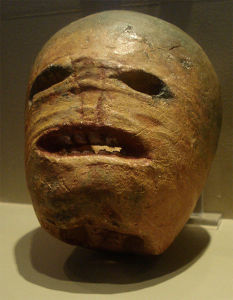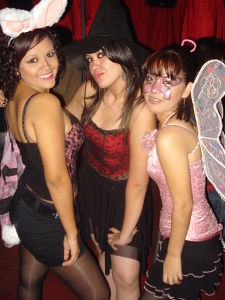The Allure of Tragedy and Horror – Happy Halloween
Friday, October 31, 2014 by Jonathan R. Gibbons in
Halloween provides an excellent example of the popular allure of the grotesque, which has transcended time. This is a photo of a traditional Irish Halloween Jack-o’-lantern from the early 20th Century. Photo Credit
Why do so many people enjoy watching horror, slasher, and psychological-thriller films? Is there a danger in watching such depictions of violence and trauma? Could it be that there is an unconscious desire within each of us to witness– or even worse partake in –violence and other tragedy; a sort of latent primordial trait (the attraction to violence and the grotesque) that was common among our most ancient of ancestors? Unfortunately, there has not been a great deal of research into these questions. Hence, the majority of information addressing them is limited in scope and/or entirely hypothetical. They also tend to have authoritarian agenda’s backing them up, such as the banning of horror films, heavy metal music, and other similar forms of art. Additionally, as is true of all the social sciences, such questions involving the complex psychology and behavior of human beings is going to be, at best, only true for the average or majority, but it’s never applicable to everyone. Everyone is unique and broad stroked assumptions about human behavior are limited. This writing is no different as it too makes assumptions that are clearly not true for every single individual; obviously not everyone enjoys horror films, or stops to observe the scene of an accident hoping to catch a glimpse of the devastation.
Certainly the majority of Romans were quite barbaric as they sat and enjoyed the “entertainment” of gladiators/slaves killing one another. Likewise, the mob loved to watch the hanging of “criminals” and “witches” during early American history. Presently, people drool at the opportunity to witness a fight, a lethal injection, videos of actual accidents, to catch a glimpse of the victims and carnage of a terrible accident on a highway as they pass by, or to read every story and obsess over every detail of a serial killer or a mass shooter. In many ways, modern attraction to tragedy is even more abundant than it was in our past given the ease of access to such events made possible via the internet. For example, YouTube epic fails and you’ll stumble upon numerous videos depicting serious accidents which have received millions of views. Stories of tragedy and violence dominant news coverage. The overwhelming majority of serialized television shows are “cop dramas” with a genre twist. They focus on the investigation of heinous crimes of a violent nature. It seems whether it’s real or fictional, people love beauty, romance, comedy, and brilliance, but they also love– indeed they obsess –over all things grotesque; perhaps they are lured to tragedy and the grotesque more so than anything else.
Some scholars believe there is a need for concern over this obsession with horror. For example, Scott Woodcock concludes that while there could be, “…benefits of horror films,” we should, “…weigh them against the potential corruption of our sympathetic attitudes. The results of this scrutiny will be complicated and unique for each film, but the rise of sadistic violence in recent horror films makes engaging in this kind of evaluation a pressing moral responsibility” (Woodcock 2013, 323).
The few psychological analyses that I’ve examined have hinted at an underlying sense of pleasure that comes from watching depictions of violence in horror films (Keisner 2008). This isn’t a pleasure that the person is happy to see a fictional person hurt, but rather that they do not have to act in response to the stimuli. As Norman Holland explains:
I think we turn to literature, to stories, poems, plays, or movies, in order to have our emotions stimulated, even in unpleasurable ways. We do so because we experience, even during the literary work, a continuing release of psychic energy (brain effort) from knowing at a cortical, cognitive level that we do not have to act in response to those sub-cortical, emotional signals. We know before we enter the movie theater that we will feel unpleasurable fear during the movie or the story, but we also know that we will feel pleasure (even during that fear!) because we know we won’t have to do anything about it. (Holland 2010)
The human life experience consists of various negative and positive emotions and feelings which often work together to fulfill a greater psychological purpose. Pain and pleasure are often encapsulated within a larger philosophical/psychological need to feel alive. For example, love and romance inevitably lead to pain. Such pain is a response to our being human, alive, and cognizant of our eventual loss whether it is due to death, separation, betrayal, and/or jealousies. These latter feelings and emotions are unpleasant for most, but they do provide a pleasure in addressing an overarching need for us to have a sense of purpose and meaning in life. Upon the realization that something has been lost, something which may have been taken for granted, we often become more lucid and sensitive than at any other point in our lives; we are experiencing sensations/feelings at a degree to which we haven’t felt in a very long time, if ever. By becoming complacent or apathetic and forgetting that life is short and ultimately limited, by going with the flow of daily life, we are closing ourselves off to experiencing life more fully. Exposure to tragedy, horror, and the otherwise grotesque, is one antidote to this emotional and psychological stagnation.
It is my suspicion that the allure of the grotesque/violence/horror, whether real of fictional, is deeply rooted in our unconscious desire to break free of the mundane routine of daily life. Such artistic depictions and events remind us to appreciate what can be lost at a moment’s notice. Halloween, likewise, provides us with a time of year to reflect on the dead, to celebrate the grotesque, for children to engage in the endless consumption of candy (something they normally are not permitted to do, but nonetheless want to), and to let loose by dressing up in costumes and behaving in ways that may be diametrically opposed to our conscious attire/behavior, but are truly reflective of our deepest desires and feelings; desires and feelings to embrace the present and cherish all that is important to us, before we inevitably lose it.
Sources:
Holland, Norman. 2010. “Why Are There Horror Movies?”. Psychology Today. http://www.psychologytoday.com/blog/is-your-brain-culture/201001/why-are-there-horror-movies
Keisner, Jody. 2008. “Do you Want to Watch? A Study of the Visual Rhetoric of the Postmodern Horror Film.” Women’s Studies 37, no. 4: 411-427.
Woodcock, Scott. 2013. “Horror Films and the Argument from Reactive Attitudes.” Ethical Theory & Moral Practice 16, no. 2: 309-324.




























